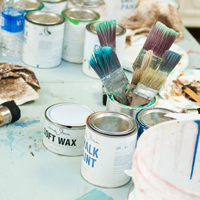The first refinishing project I ever tackled were hardwood floors. When I was about 13 or 14 years old I told my parents I wanted to rip out the carpet in my bedroom and keep the hardwood. My dad said it was OK, but I would have to do all of the work. So, we tore out the carpet and I got down on my hands and knees and sanded them down to the bare wood. Then I stained them. Then I had to sand them again!? Then stain them again!? Then sand them again!??? Then put polyurethane on them! THEN SAND THEM AGAIN BEFORE A FINAL COAT OF POLY!!!??? Talk about cruel and unusual punishment for a teenager! The results were totally worth it and now that I’m older, I’ve wised up about the use of power tools.
I have six days under my belt in terms of getting my girls bedroom finished. Yesterday and today was dedicated to refinishing the floors. No four inch hand sander for me! I wanted something with power.
The floors before. Think they need some work?
Partial solid oak and partial plywood.
And, lots and lots of gunk.
I needed to rent a drum sander to finish this job. I headed over to Home Depot after I picked my girls up from school. I had my three year old holding my left hand and my five year old holding my right hand. I strode into the tool rental department and said I needed to rent a drum sander. The guy working raised his eyebrows, pondered my request and boldly declared, “you’re not the one operating it!?” To which I said, YES…and I will have it back before my husband gets home from work!
This was my second time using a drum sander, and believe me it was totally worth the expense. I thought I would share a few helpful tips and tricks to operating it in case there is some brave soul out there on the fence about refinishing their own wood floors.
1) Be sure to have the floor completely cleared of any metal obstructions like staples and nails that at one time were holding down carpet and padding.
After I removed all of the staples, I went back over withe broom and found about a dozen that I missed. When you are using the sander, keep the pliers handy because if you start seeing sparks, you probably missed a staple.
2) Connect all of the plugs
There is a plug at the top of the handle that connects to the plug that goes into the wall. There will be a green light to show that the machine is receiving power.
At the bottom of the handle, there is another plug that connects to the base of the machine. That needs to be connected and twisted to lock. If it isn’t locked into position, the machine won’t turn on (I found this out after spending about 15 minutes on the phone with the rental center because I couldn’t get the machine to turn on).
3) Attach the sanding rolls.
I used 36 grit sanding cylinders that fit snugly on the rubber base.
Make sure that the base is in the up position (there is a lever on the handle that puts it up and down) and wiggle the roll onto the base. It is a snug fit.
4) Position the sander to start sanding. Turn on the switch by pushing down and flipping to the left. Once the power is on, lower the sanding mechanism and keep the machine moving.
Notable things to remember are:
Keep the sander moving at all times. If you pause it will eat away at the floor…literally so always have it in motion while the sander is down.
Keep it moving with the wood grain. If you move at all against the grain it will leave scratch marks all over the floor.
Start in an inconspicuous area while you get the feel of the sander. This allows you to make mistakes without it being in the middle of the room at a focal point.
When it’s all said and done, you will go from this…
to this….
…all in about an hour or two flat.
The belt sander only gets so close to the walls.
The edges need to be hand sanded in the areas where the belt sander doesn’t reach. If you don’t go down to the bare wood, you will have a border all around the room from where the stain doesn’t take…like pictured above. That corner of the room will be completely covered with furniture so I took some shortcuts.
This is where the drum sander got away from me and shifted. It left these nasty scratch marks on the floor. Fortunately, the bed will be covering up this section.
The stain was darker on the sections of plywood than the solid oak. I added a second coat of stain to the oak after lightly hand sanding the floor with 220 grit to even out the color between the different wood finishes.
By the time I get home tonight, it should be dry enough for me to add a coat of lacquer and then tomorrow I can start moving in furniture!
And…I did have the drum sander back to Home Depot before my husband got back from work. Not bad for one afternoon!
















